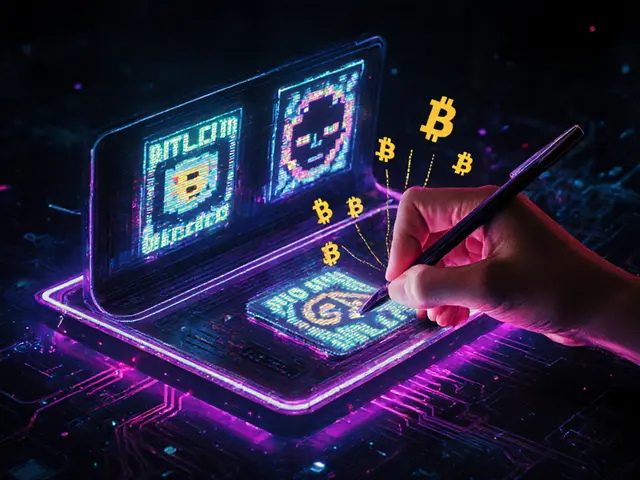SSI Verification Cost Calculator
SSI Verification Cost Estimator
Results will appear here after calculation
Quick Takeaways
- Self‑sovereign identity (SSI) lets you own and control your digital ID without a central gatekeeper.
- Three technical pillars-Decentralized Identifiers (DIDs), Verifiable Credentials (VCs), and blockchain-make SSI possible.
- Public blockchains (e.g., Ethereum) cost about $0.45 per verification, while purpose‑built networks like Sovrin Network can handle 1,000tx/s with virtually no fees.
- Adoption is spreading in government, finance, and healthcare, but user‑experience and key‑management remain the biggest hurdles.
- Start with a simple SSI wallet, back up your seed phrase, and test with a verifiable credential from a trusted issuer.
What Is Self‑Sovereign Identity?
Self‑sovereign identity is a digital identity model that puts individuals in full control of their personal data. Unlike traditional logins that rely on Google, Facebook, or corporate directories, SSI lets you create, store, and present identity attributes only when you choose to. The concept emerged around 2015 as blockchain technology matured and the FIDO Alliance began promoting a shift away from account‑based systems.
The Three Technical Pillars of SSI
SSI doesn’t float in a vacuum; it rests on three interoperable components.
- Decentralized Identifiers (DIDs) - Unique, user‑controlled strings that resolve to a DID document without any central authority. The W3C DID Specification 1.0 (July2022) defines the format and resolution process.
- Verifiable Credentials (VCs) - Cryptographically signed digital attestations (e.g., a driver’s license or university degree). Dock Labs’ VC framework (Feb2024) specifies how signatures prove authenticity while keeping the data tamper‑proof.
- Blockchain Infrastructure - The immutable ledger that anchors DIDs and timestamps VCs. Both public chains like Ethereum and permissioned networks such as Sovrin Network are used in real deployments.

How Blockchain Makes SSI Trustworthy
Blockchains provide three essential guarantees for SSI:
- Immutability - Once a DID is written, no one can alter its public key without a verifiable on‑chain transaction.
- Transparency - Anyone can resolve a DID to see the associated verification methods, which helps auditors detect fraud.
- Resilience - Distributed nodes eliminate a single point of failure, reducing the risk of mass data breaches like the 2023 Facebook leak (419M accounts).
For example, a Canadian citizen applying for a digital health card can receive a VC from the provincial health authority. The VC’s hash is stored on Ethereum, so the citizen can later present the credential to a hospital without the health authority ever seeing the transaction again.
Centralized vs. Self‑Sovereign Identity: A Side‑by‑Side Look
| Aspect | Centralized (e.g., Google Sign‑In) | Self‑Sovereign Identity |
|---|---|---|
| Data Owner | Identity Provider | Individual |
| Storage | Provider’s servers (single‑point of breach) | Encrypted wallet on user device or hardware token |
| Recovery | Password reset, often via email | Seed‑phrase or backup key management |
| Privacy | Attribute disclosure is all‑or‑nothing | Selective disclosure via zero‑knowledge proofs |
| Cost per verification | Free for user, cost hidden in provider’s infrastructure | $0.02‑$0.45 on public chains; near‑zero on permissioned nets |
Real‑World Use Cases That Show SSI’s Value
Government IDs: British Columbia’s Verified.Me processed 1.2M verifications in 2023 with zero breaches. The EU’s eIDAS2.0 regulation now mandates SSI‑compatible solutions across member states.
Financial KYC: JPMorgan’s pilot cut verification time from 3‑5days to under 2hours. 63% of major banks are testing SSI for KYC, according to Deloitte’s 2024 banking survey.
Healthcare: The European Health Network (EHN) uses SSI to let patients share vaccination records across borders, serving 450M citizens while staying HIPAA‑like compliant.
Education: A pilot in Indonesia issued digital birth certificates via the ION framework; retention jumped to 92% versus 63% for paper‑based processes.

Adoption Hurdles and How to Tackle Them
Even with technical advantages, SSI faces three practical roadblocks.
- Key Management Fear - 68% of non‑technical users struggle with private keys (IEEE 2023). Solution: use custodial wallet services that escrow keys under a legally‑binding SLA, but choose providers with transparent audit logs.
- UX Complexity - Civic’s onboarding abandonment rate sits at 72% (UX Collective 2024). Solution: adopt “universal wallet” specs (target Q22025) that let users sign in with a single biometric gesture.
- Regulatory Fragmentation - China’s blockchain ID diverges from Western standards, creating cross‑border incompatibility. Solution: stick to W3C/DIF standards, which most governments (EU, Canada) have already endorsed.
Getting Started: A Simple Checklist
- Pick a reputable SSI wallet (e.g., Trinsic, Microsoft Entra Verified ID).
- Back up your seed phrase on paper and in a secure password manager.
- Obtain a verifiable credential from a trusted issuer (government ID, university degree, or employer).
- Test selective disclosure by presenting only the needed attribute (e.g., age‑over‑18 proof) to a service.
- Monitor transaction fees if you’re using a public blockchain; switch to a low‑cost layer‑2 if costs rise.
Developers can follow the Decentralized Identity Foundation’s 7‑step integration guide: resolve DID → verify VC signature → check revocation status → store proof in an off‑chain encrypted vault.
Frequently Asked Questions
Do I need a blockchain to use SSI?
A blockchain (public or permissioned) provides the immutable anchor for DIDs and VCs, but the actual credential exchange can happen off‑chain. Some pilots store only a hash on‑chain, keeping data private.
What’s the difference between a DID and a traditional username?
A DID is a cryptographic identifier that can resolve to multiple verification methods, while a username is merely a string tied to a single provider’s database.
Can I lose my digital identity if I forget my seed phrase?
Yes. The seed phrase is the root of your cryptographic keys. Recovering without it is effectively impossible, which is why secure backups are critical.
How do privacy‑preserving proofs work?
Zero‑knowledge proofs let you demonstrate that a credential satisfies a condition (e.g., age>18) without revealing the exact data. The verifier checks a cryptographic proof instead of the raw attribute.
Is SSI ready for everyday consumer apps?
Adoption is growing, but mainstream apps still lag behind due to UX challenges. Expect broader consumer roll‑out after the Universal Wallet spec lands in 2025.





Comments
12 Comments
Brandon Salemi
Wow, SSI is blowing my mind! The idea of owning your identity on the blockchain feels like stepping into a sci‑fi novel.
Hanna Regehr
For anyone worrying about user experience, most wallets now let you scan a QR code and instantly prove a credential without exposing the raw data. It’s a subtle UX win that keeps the process frictionless while staying secure.
Orlando Lucas
Self‑sovereign identity invites us to rethink the social contract between citizens and institutions. If you can verify who you are without handing over a centralized database, power shifts back to the individual. It also forces governments to adopt standards that are interoperable across borders. Think of the possibilities for refugees who need portable, verifiable documents. The philosophical stakes are as high as the technical ones.
Siddharth Murugesan
i cant belive how many ppl still think ss is just another crypto hype. the tech is solid but the real world apps are lagging. also the docu is full of buisness jargon no one reads.
Jade Hibbert
Oh great, another buzzword. At least it’s not as boring as “blockchain for everything”.
Leo McCloskey
Indeed-while the hype ramps up, the actual on‑chain gas costs for verification on Ethereum remain prohibitive for mass adoption; one must consider L2 solutions or permissioned ledgers to achieve scalability, otherwise the model collapses under its own weight.
Anjali Govind
Honestly, the biggest barrier isn’t the tech-it’s the mindset. People are used to logging in with a password, not a cryptographic proof. If we can design a wallet that feels as easy as checking email, adoption will skyrocket.
Ben Parker
Totally get you! I tried a self‑sovereign wallet last week and it was smooth AF 😎👍. Just a few taps and I proved my age to a retailer without giving away my DOB. 🎉
Lena Vega
SSI could slash identity theft rates dramatically.
Mureil Stueber
And because it’s decentralized, no single entity can lock you out of your own credentials. That’s a game‑changer for digital rights.
Emily Kondrk
The moment you start digging into the layers of Self‑Sovereign Identity, you realize it’s not just a technical protocol but a sociopolitical rebellion wrapped in cryptography. Governments love to whisper about “digital identity” in boardrooms, yet they secretly fear the erosion of their surveillance apparatus. Imagine a world where you can walk into a bank, flash a zero‑knowledge proof, and the teller instantly knows you’re a verified citizen without ever seeing your passport number. That’s the power of zk‑SNARKs-cryptographic magic that convinces without revealing. Meanwhile, the so‑called “big tech” lobbyists are busy drafting legislation to label these proofs as “high‑risk financial instruments” because they can’t control the narrative. It’s a classic case of the elite trying to re‑brand a liberating technology as a threat to the status quo. On the technical side, the DID (Decentralized Identifier) spec keeps evolving; today it’s a simple URI, tomorrow it could be a quantum‑resistant post‑quantum identifier. The ecosystem is a patchwork of standards-W3C, DIF, and a handful of open‑source projects-all trying to avoid the trap of monopoly control. For developers, the learning curve feels like climbing a mountain made of legal jargon and blockchain concepts, but the summit offers unprecedented user agency. Users finally get to decide what data they share, with whom, and for how long-a stark contrast to today’s cookie‑laden consent forms. The economic incentives also shift: issuers can monetize verification as a service, while users retain ownership of their credential wallets. In the end, SSI is a mirror reflecting our collective desire for privacy, autonomy, and trust in an increasingly digitized society.
Annie McCullough
Sure, it works fine until the next update breaks everything 🙄 :/
Write a comment